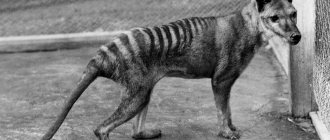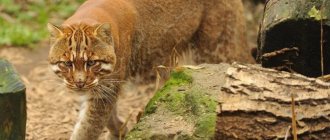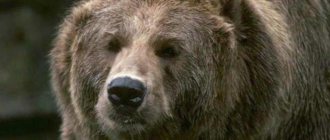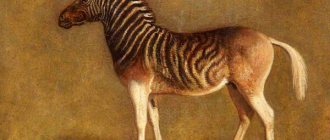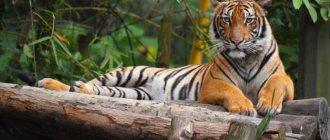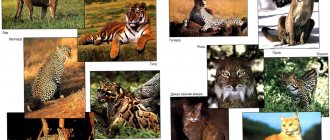All representatives of the feline species, just like humans, have ancestors named by researchers neophelides And paleofelids. Neophelids represent the forerunner of all cat species. Paleophelides is a side branch that included the most ancient saber-toothed animals, as well as nimravines.
Research by scientists has shown that these amazing creatures, from which modern cats trace their ancestry, inhabited our planet approximately 25 million years ago. It still remains a mystery what caused the disappearance of the paleofelids from the face of the earth. This may have occurred as a result of changing climatic conditions.
Let's consider all the descendants of the neophelides, who, according to scientists, inhabited the earth during different periods of the development of life on the planet.
The most ancient of them is considered to be a medium-sized (something between an ordinary modern cat and a cheetah) predatory animal that obtained its food by hunting. This is the so-called Pseudaelurus, which existed approximately 20 million years ago.
The next stage in the development of representatives of this family was the emergence of two more varieties. A typical representative of the former was the saber-toothed tiger, an animal of enormous size, clumsy, but predatory and dangerous. The prey of the saber-toothed tiger, as a rule, were herbivores. This animal is notable for its sharp and very long fangs.
Findings discovered by researchers suggest that the length of the fangs of these neophelide descendants could reach 20 cm or more. Modern man has the opportunity to quite clearly imagine the appearance of a saber-toothed tiger thanks to numerous engravings and illustrations. The terrifying fangs were visible even if their owner closed his mouth.
These contemporaries of the Ice Age, who lived at the same time as huge animals that fed on plant foods, became extinct approximately 10 million years ago. Animals of another group became the ancestors of modern pets and other small energetic animals of this species that inhabit our planet in abundance. Neophelids were the ancestors of huge animals, similar in size to modern tigers or lions. These prehistoric cats became extinct relatively recently - about one million years ago.
Cats these days
Now let's turn to the feline species, which has managed to survive to this day, mainly due to qualities that provide it with greater ability to adapt to environmental conditions than other relatives. As a result of long-term evolution, the following descendants of the genus of cats that currently live on earth came from neophelides: these are cheetahs and cats.
Cheetahs are an independent species of this family.
Cats are divided into large and small. The first branch includes modern tigers, jaguars, lions and leopards. Small predators include relatively small predators that differ in both color and size. These are all breeds of domestic cats known to us, as well as lynx, puma and some others.
Very few reliable facts have reached us about the wild ancestors of our beloved cats. Nevertheless, researchers are working in this direction, trying to collect and organize the information obtained into a single picture.
Bali tiger
As you might guess from the animal's name, the Bali tiger was native to the Indonesian island of Bali, where the last individuals became extinct only about 50 years ago. For thousands of years, the Bali tiger has been at odds with the indigenous peoples of Indonesia. However, the proximity of local tribes did not pose a serious threat to these tigers until the arrival of the first European traders and mercenaries, who ruthlessly hunted Balinese tigers for sport and sometimes to protect their animals and estates.
Big cats
So, big cats. What is known about them? Firstly, they are of respectable size and have identical features. First of all, these are external signs. In addition, they lead the same lifestyle and use almost the same methods to get their food.
Surprisingly, but true: representatives of the feline family, such as tigers and lions, can mate with each other, and the existing genetic differences do not leave their mark on the offspring.
However, despite similar characteristics, there are significant differences between them. This is not surprising if we take into account the living conditions of these animals. Lions are a more family-oriented species, having a single leader and a small number of females with many cubs, which are looked after by all the females, regardless of who their mother is, as well as teenage lions. As soon as the young animals grow up, the leader kicks adult males out of the flock, protecting himself from potential competitors. Another surprisingly cruel fact from the life of lions is that if a new leader appears in a pride (for example, if the previous one becomes weaker or grows old and can no longer provide worthy resistance to young males), the first thing he does is get rid of all the cubs in the pack.
The tiger lives alone, looking for a mate only during the mating season. When hunting, the tiger also acts as a hermit. As a rule, he forages for food alone. Having caught the prey, the tiger will slowly eat it, and none of the animals will dare to join this meal.
The lion acts differently . He will not hunt in splendid isolation. The main hunters of prey in lion prides are females. Lions, as a rule, go out hunting in groups, chasing one animal, which then becomes common prey. Lions can also go without food for a long time, despite their amazing appetite (an adult lion can eat an amount of food equal to a third of its body weight at one time). A well-fed lion can sleep up to 20 hours and not go hunting for a week.
of a pack of cats is interesting . In this community, the leading role is played by females, around whom the rest of the animals unite. This is evidenced by the already mentioned fact of the distribution of roles in the pride. Moreover, if the existence of male representatives in a flock is very unstable (they can be driven away by stronger relatives), then the composition of female cats, as a rule, does not change.
Other felines also have their own characteristics. For example, a leopard does not growl. This is due to the specific structure of this cat’s vocal cords. The jaguar has many interesting features. Its most important difference is its coloring. In terms of nutrition, this predator can be considered a gourmet, since it prefers to feast on turtles. The peculiarity of the motor system allows large species of cats to move at considerable speed.
Gifts and offerings
From left to right: Guyer-Anderson's Cat, 664-332. BC. \ Cat-headed deity Bastet.
While the unauthorized killing of cats was prohibited, thousands of felines were ritually killed at one of Bastet's many temples. Large nurseries located on the temple grounds specially bred animals for use as offerings. Cats sacrificed in ancient Egypt were then mummified and buried in nearby cemeteries dedicated to the goddess. Cat cemeteries grew to such a level that countless cat mummies were discovered during 19th-century excavations. Many mummies were carefully wrapped in decorative headdresses. Others were encased in specially crafted cat statues or decorated sarcophagi, like Thutmose's beloved Ta-Miu. These finds were so widespread that the British began exporting cat mummies to England for use as fertilizer (at one point bringing over one hundred and eighty thousand in one shipment).
Cat-like animal slaying the serpent Apophis, Theban Tomb of Incherkh, circa 1160 BC. \ Photo: artmoneyprovenance.com.
Not all cats suffered a cruel fate before they were mummified. Purrs in ancient Egypt could also be buried with their people. According to the Book of the Dead, the owners believed that they would be reunited with their loyal protectors in the afterlife. Others buried their beloved pets in special pet cemeteries, where archaeologists have discovered the remains of well-cared for cats that often died of old age.
Cat mummies in the British Museum, London, UK.
Herodotus described the grief caused by the loss of a beloved pet. After a cat died a natural death, all household members shaved off their eyebrows as a sign of grief. Another account tells of Egyptians stranded in a burning building who rescued their cats before either saving themselves or attempting to put out the fire.
Small cats
This category of the cat family includes representatives of small sizes. The peculiarities of their constitution are such that they can hunt only small game or insects, devoting almost the majority of their time to this activity. Despite their physical characteristics, small cats are just as tenacious as their large relatives. To provide themselves with food, they sometimes hunt for almost days, devoting a small part of the time to sleep, compared to their larger brothers.
Ocelot - spotted wild cat
Representatives of the cat family belonging to this category are the ocelot , lynx , tiger cat and others, each of which has its own characteristic features. An interesting animal is the ocelot. It is almost impossible to see it in Russian zoos. This cat usually lives in forests, rocky and swampy areas of South and North America. The ocelot does not hunt under the cover of darkness. Like many other cats, it climbs trees well. His ability to swim well is unusual. It is easy to train, but at the same time the nature of its behavior changes relative to its habitat in natural conditions.
Another representative of small cats is the lynx. It can be easily recognized by its small tufts on its ears and small tail.
Lynx lives in forests, steppes and deserts. The most striking representative of this species is the common lynx, which is distinguished by its special strength and beauty. It is a source of danger for many forest inhabitants. The prey of this cat can be deer and elk, which indicates that the described animal has considerable strength. The common lynx climbs trees well and usually hides on one of the lower branches, setting up a kind of observation post there. It is capable of waiting for prey for a long time, and when a potential victim appears in sight, it quickly attacks it from above, biting the neck area. Such an attack sometimes ends in failure for the lynx, and the potential prey manages to escape.
The lynx has such a feature, characteristic of some predators, as greed , killing too many victims, some of which remain uneaten by it. There are known cases when lynxes killed entire herds of animals. If frequent attacks by this wild cat are a threat to the household, people try to protect themselves from this scourge by going hunting. However, this is quite a dangerous business. A wounded lynx becomes a very serious enemy and can rush at a person. Nevertheless, in the animal’s habitats, hunting for this representative of cats is popular, since its fur is very valuable.
Cheetah
Such a representative of the cat family as the cheetah cannot be classified as either small or large cats. He is the only representative of a very special category of this family. The cheetah is capable of developing truly fantastic speed, and this helps him in the hunt. It also leaves its mark on the choice of hunting method. The cheetah absolutely does not know how to sneak up on its prey unnoticed. But in the role of a pursuer he has no equal.
The cheetah's habitat is considered to be steppe areas. As a rule, cheetahs hunt gazelles and other herbivores. The long-described predator has been nicknamed the hunting leopard, and this nickname reflects the dexterity and agility with which they catch prey.
American lion
As with the American cheetah (see previous point), the relationship of the American lion to modern lions is much debated. According to some sources, this Pleistocene predator is more closely related to tigers and jaguars. The American lion coexisted and competed with other superpredators of the time, such as the saber-toothed tiger, the giant short-faced bear, and the dire wolf.
If the American lion was in fact a subspecies of lion, then it was the largest of its kind. Some alpha males reached weights of up to 500 kg.
Snow Leopard
The snow leopard blends perfectly with the surrounding nature, but this will not save it when it meets a person.
Neither does the snow leopard or the snow leopard. The “ghost” predator lives mainly in the mountainous regions of Central Asia. The secretive lifestyle, as well as the inaccessibility of the snow leopard's habitats, makes it difficult to estimate the population, but experts believe that the number of this species is continuously declining. The main reason for the extinction of the snow leopard is the illegal hunting of the animal for its magnificent skin. A big problem is the undeveloped defensive behavior of the snow leopard, which, when meeting a person, prefers to timidly freeze against the backdrop of mountain slopes instead of fleeing from an armed poacher like the plague. The lack of enemies of the snow leopard among other predators played such a cruel joke. As you understand, such encounters usually end in death for the animal.
The number of snow leopards, according to WWF, is about 4,000 individuals; only 70-90 snow leopards live in Russia.
Javan tiger
The Javan tiger, like its close relative the Bali tiger (see point 3), was limited to one island in the Malay Archipelago. Despite relentless hunting, the main reason for the extinction of the Javan tiger was the loss of habitat due to the rapid growth of the human population in the 19th and 20th centuries.
The last Javan tiger was seen in the wild decades ago. Given the overpopulation of the island of Java, no one has much hope for the recovery of this subspecies.
Habitat
The living space of the predator stretched from the foothills of the Tien Shan along the river floodplains, captured Turkmenistan, the territory of Turkey, Iraq, Pakistan, and occupied Kazakhstan, Afghanistan, Kyrgyzstan, and Uzbekistan. The Latin name of the subspecies is Panthera tigris virgata.
The name “Turanian tiger” appeared due to the name of the lowland where the predator lived. Since it was also found off the coast of the Caspian Sea and in the Transcaucasian region, two more names were assigned to the animal - “Caspian tiger” and “Transcaucasian tiger”. According to some reports, in search of prey, the animal could reach the eastern borders of Kazakhstan and Altai.
Wherever the predator lived, the main habitat requirements were the presence of dense vegetation, a source of running water, and a sufficient supply of primary prey (pigs, deer). The animals chose juniper and mixed forests, dense tugai thickets along river banks, low foothills and lowlands, and were occasionally found at altitudes from 1.5 to 4 thousand meters.
Within the boundaries of the hunting grounds, the density of reeds was sometimes so high that the animal had to rise on its hind legs to look around. The Turan tiger in Kazakhstan lived near Lake Balkhash.
This is interesting: The mysterious animal jaguar and where it lives
Barbary lion
One of the most fearsome subspecies of lion was the Barbary lion, a prized possession of medieval British lords who wanted to intimidate their peasants. Several large individuals made their way from northern Africa to the zoo located in the Tower of London, where many British aristocrats were previously imprisoned and executed. Male Barbary lions had especially thick manes, and reached a mass of about 500 kg, which made them one of the largest lions that ever lived on Earth.
There is a high probability of the revival of the Barbary lion subspecies in the wild through the selection of its descendants scattered in zoos around the world.
Amur forest cat
The Amur cat lives in most reserves of the Primorsky Territory
. Another name is the Far Eastern cat. It is a subspecies of the Bengal cat. Habitat: Far East, coast of the Sea of Japan. The species is considered rare and is listed in the Red Book of the Russian Federation. The population of the Primorsky Territory numbers about 2-2.5 thousand adult individuals, and the population is currently growing. The species is threatened by weather conditions, habitat degradation, and interbreeding with domestic cats. The population of the Far Eastern cat on the Japanese island of Tsushima (where the species is called the Tsushima leopard cat) numbers only about 100 individuals and is under state protection.
Fourth place – Leopard (Panthera pardus)
Leopard
The fourth largest wild cat is the leopard. There are 9 subspecies of leopard (African, Indian, Javan, Arabian, Anatolian, Amur, Indochinese, Sri Lankan), which are found in Africa, East and South Asia. These cats live in tropical forests, deserts, savannas, grasslands, mountains, coastal areas, scrub and swampy areas.
Leopards spend a lot of time in trees and are active mainly at night. Leopards have a muscular, flexible body, they run at a speed of 60 km/h, and jump 6 meters in length and 3 in height. Like pumas, leopards are solitary, territorial, predatory animals. Leopards roar, growl, meow. Their roar is associated with the spraying of wood.
Leopard fur color ranges from pale yellow to tan or gold. There are dark spots on the body, which are called “rosettes” because they are shaped like a rose. Males are larger and heavier than females: 40-90 kg versus 30-60 kg.
Leopards are endangered. The rarest subspecies, the Amur leopard, is found in the Far East, Korea and northeast China, with only 30 individuals in the wild. The average lifespan is 12-17 years in the wild and up to 23 years in zoos.
Owen's Panther
Cougar pardoids lived in Asia and Europe during the late Pliocene era . It is considered to be the species that immediately preceded the puma as we know it today, although some of its remains also bear similarities to living leopards...
There is little information about this species. It is known as Owen's panther because of Richard Owen, who described it, but it is sometimes also known as the Eurasian puma. There is little information about this species. It is speculated that their extinction was at the hands of larger predators that drove them out of the areas where they hunted for food, harming their survival...
Caucasian jungle cat
House prefers to live near bodies of water, hiding in the thickets of cattails.
This cute fellow inhabits the Caucasus, Iran and the regions of Turkey bordering Transcaucasia. In Russia, it can be found in the Volga delta, in cattail and reed thickets. Another name for this species is swamp lynx or house. The number of Hausas has a pronounced downward trend; according to approximate data, in Russia the population barely reaches 500 individuals.
In some regions, the population of the jungle cat is close to extinction, the reason for this is the anthropogenic impact on the reed and reed lands in which the house lives (draining wetlands, burning and mowing down thickets). The bog lynx does not tolerate frost well, so particularly cold winters also contribute to a decline in the population. By the way, the House sometimes crosses with ordinary domestic cats; there is even a special breed of Chausie cats, for which a jungle cat was used.
